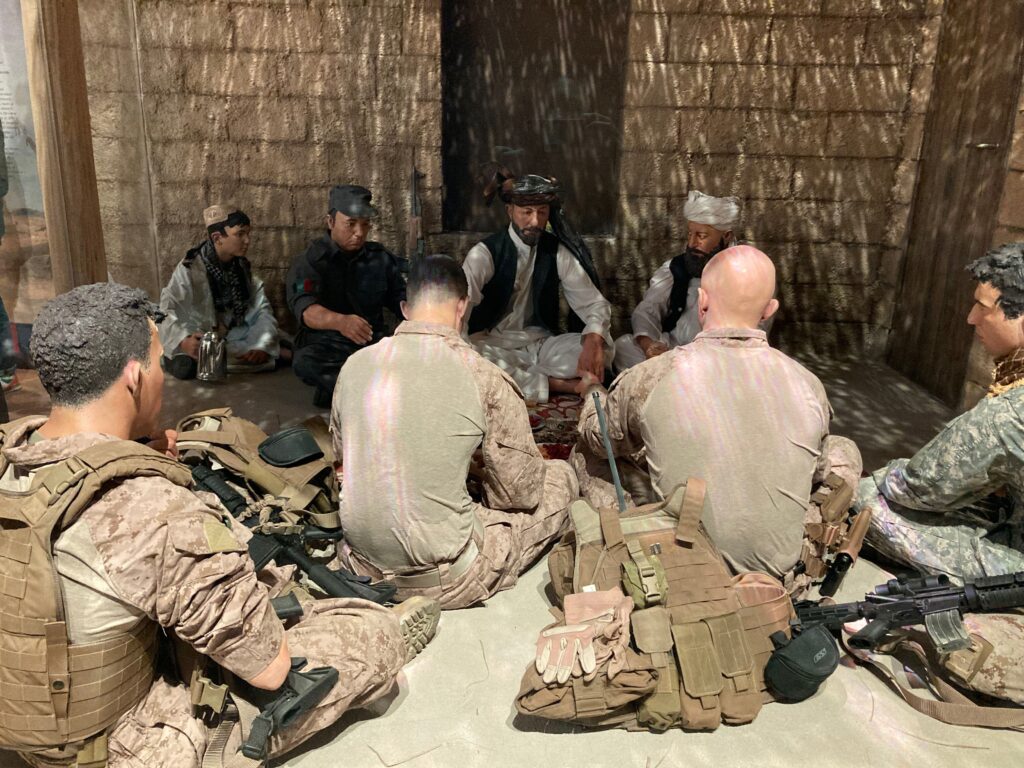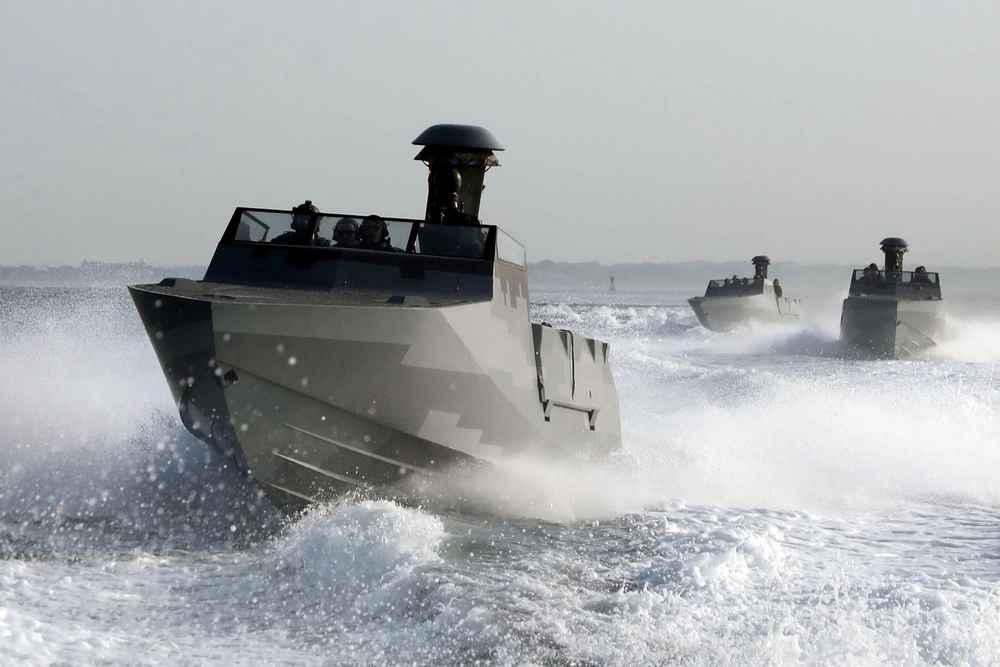Outside a new immersive exhibit depicting a narrow city street in Fallujah, Iraq, visitors get fair warning about what they’re in for: “This exhibit contains scenes, sounds, and smells that simulate a combat environment in Iraq as well as tight or enclosed spaces. Those who wish to bypass this scene may go through the doors to the right.”
That’s not an exaggeration: Smell is one of the senses engaged, to powerful effect, in the newest galleries at the National Museum of the Marine Corps in Quantico, Virginia.
While the scent cannons weren’t active when Sandboxx News took a media preview tour on September 18, Museum Director Keil Gentry described the bouquet that future visitors will experience: feces, burning trash mixed with burning plastic, cordite… copper.”
As Brig. Gen. Matthew Tracy, president of Marine Corps University pointed out, that noxious smell will carry mixed associations for the veterans who walk through the exhibit. A veteran of Iraq himself, Tracy remembered the combination of burning fuel and feces as distinctive to the forward operating bases, where trash fires would be lit throughout the day.
“It was the smell of returning back to the FOB and safety, and so for me, the smell became associated with that,” he said.
The jarring moments of realism go beyond the scents, though. In the Fallujah gallery alone, a video depiction shows a squad of Marine re-enactors conducting house-clearing operations. One version of the operation shows the Marines bursting into a home while an Iraqi family inside screams in terror. Another shows them encountering armed insurgents. Off-screen shooting ensues.

The 20,000 square feet of new gallery space is the product of more than a decade of brainstorming and expert input, plus five years of delay caused by COVID-19 and other factors. But the final result is poignant and at times breathtaking.
One cavernous exhibit, in a nearly all-dark room, immerses visitors in a nighttime forward arming and refueling point mission. As the video simulation concludes, the air fills with smoke, and the visitors’ attention is drawn to the real UH-1 Huey helicopter looming over them at the center of the exhibit, with life-cast Marine figures conducting a rearming operation.
Behind glass at the far end of the room hangs the grimy combat uniform of retired Lt. Gen. Richard Natonski, who led the Marines of Task Force Tarawa in the Battle of Nasiriyah as they marched up to Baghdad in 2003. He’d later lead the Marine ground maneuver element in the 2004 Battle of Fallujah.
Natonski, who served as an advisor for the development of the new galleries, stood by that old uniform as he told Sandboxx News he was grateful the exhibit would be open in time to mark Fallujah’s 20th anniversary in November. He pointed to the other combat gear in cases around him, including a blouse belonging to Staff Sgt. Jeremiah Workman and body armor belonging to Sgt. Rafael Peralta, both Navy Cross recipients. While Natonski recommended Peralta for the Medal of Honor for his actions during the Second Battle of Fallujah, he would ultimately receive the Navy Cross; there have been numerous attempts to upgrade his award.
“I think veterans will come away with greater appreciation for what they did, and the opportunity to show their families, ‘I was there,'” Natonski said.
Related: Visiting the impressive National Infantry Museum

For those who find the sights, sounds, and smells a little too real, the museum recently dedicated a “respite room” adjacent to the new exhibits, allowing visitors to enter a soundproof and tranquil sitting space to reflect or just dial back the intensity.
For some, the exhibits will put them face-to-face – literally – with their own combat history. One display, featuring a hulking Mine-Resistant Ambush-Protected All Terrain Vehicle (M-ATV) and a crater beneath it from a freshly detonated improvised explosive device, included a life cast of a Marine officer radioing back to an operations center. For retired Marine Maj. David McGrath, that’s not just his actual M-ATV at the center of the exhibit; it’s also his own face on the figure.
McGrath told Sandboxx News he’d been at the Command and Staff School in Quantico when he was approached by a museum curator, who took him to see the battle-damaged M-ATV, in storage in a warehouse on the base. McGrath immediately recognized his own writing on the windshield – frequencies for a Medevac report – and even the cans of Red Bull sitting inside.
“It was surreal to see that,” he said.
The museum enlisted him to help recreate the day of the IED blast in Helmand, an event that he and his crew members fortunately survived with only minor injuries. In what McGrath called a “crazy … Hollywood day,” he was brought in to pose for his own figure, his face and body covered in hot silicone to create an exact twin.
Related: How the Army’s Delta Force and Night Stalkers teamed up to rescue hostages in Iraq

When he visited the exhibit recently with his family, he said his mother, in particular, was overcome by the emotion of seeing the realities of where and how her son had served.
“Seeing it all together, I felt fortunate, honestly,” McGrath told Sandboxx News. “There are a lot who were less fortunate than me, and IEDs are a devastating tool of warfare. I’m thankful to be standing here talking to you… it could always be worse.”
Some might wonder why certain aspects of the wars – such as the Marines’ historic and costly Afghanistan battles in Sangin and Marjah – are not addressed in more specificity. That’s partially due to the time it takes for artifacts to accumulate, said Chuck Girbovan, the museum’s branch chief for exhibits.
“We don’t actively solicit, so we have to wait for donations to come in,” Girbovan said, adding that many Marines and family members weren’t yet ready to part with mementos from the recent wars.
“Our expectations are that now that the gallery’s open to the general public, more donations will come in, and I would expect that these galleries would change much faster than our previous galleries have.”
Related: The history of MARSOC is the history of the Marine Raiders

However, what is included is deliberate and significant. At the end of the narrow street in the Fallujah gallery, two female Marine life-cast figures talk with a woman in a hijab. They represent the Lionesses of Iraq and Female Engagement Teams (FETs) of Afghanistan who embedded with male infantry units to conduct culturally sensitive tasks, such as searching and questioning women. While female Marines were not technically permitted in combat at the time, these teams quietly served on the front lines and faced all the accompanying dangers.
Saje Mrowinski, who served on a FET in Afghanistan and later supported the lawsuit that won women the right to serve in combat, said seeing her service as a part of the narrative of the wars was exciting and validating.
“To be here to be a part of this, and to see it represented for both the Lionesses and the FETs, is extremely honorable, and we’re just so grateful,” Mrowisnki said.
Set to open on October 6, the two galleries will encompass the period of warfare from 1976 to the present, including the post-9/11 wars in the Middle East.
Read more from Sandboxx News
- Video: American F-35s landed on a highway near Russia
- These are the pistols that America’s generals carry
- The Intelligence Support Activity – one of America’s most secretive special operations units
- The ACR program or how the Army spent 300 million dollars on nothing
- Video: The Air Force wants to push the F-22 further







